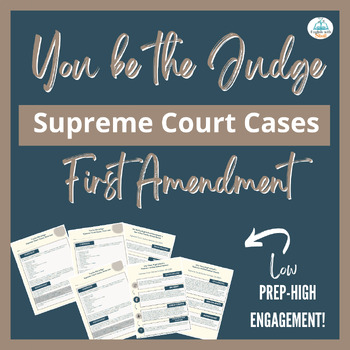You Be the Judge: Supreme Court Cases, First Amendment, PBL (Journalism)
- Zip
Also included in
- ⭐️ Press Law and Ethics Unit:This is a comprehensive student press law unit plan that is designed to walk students through an introduction to the First Amendment, Hazelwood, and landmark Supreme Court cases, and their impact on student press rights. Students will also learn about ethical consideratioPrice $16.17Original Price $17.97Save $1.80
Description
Help your students apply their understanding about the First Amendment, landmark Supreme Court cases, and their Constitutional significance by engaging in this fun authentic project-based-learning activity. This highly engaging activity asks students to put themselves in the shoes of a Supreme Court judge by evaluating a fictional Supreme Court case and drawing conclusions based on research.
➡️ There are 15 fictional cases on the following topics:
- Anonymous sources
- Controversial topics
- Data privacy
- Editorial independence
- Libel (public figures and private citizens)
- Misquoting sources
- Photography
- Prior review
- Private schools
- Provocative content in theater
- Slander
- Social media
For each case, students will be provided:
- Background
- A description of the incident
- Lower court decisions
- A constitutional question this case addresses
- Arguments on both sides
- Amicus briefs
- Significance of the case as it relates to the First Amendment
*A list of website links and resources are included so students have a starting point!
➡️ Included in this resource is an assignment which outlines the following steps: an overview of the incident, research the legal precedent based on landmark Supreme Court cases, and formulate a decision based on the evidence and conclusions.
An editable grading rubric is included to assess your students on their project.
This project can be completed individually, in pairs, or small groups for cooperative learning groups.
★Be the first to know about my sales, freebies and new resources. Look for the green star next to my store logo and click it to FOLLOW ME. You will now receive weekly email updates about my store and products!
➡️ Did you know? You can get TPT credit to use on your future purchases!
To earn free credits on future purchases:
- Go to your My Purchases page (you may need to login).
- Next to each purchase, you will see a Provide Feedback button.
- Click it and you will go to a page where you can give a quick rating and leave a short comment for about the product.
- Each time you give feedback, TPT gives you feedback credits you use to lower the cost of your future purchases.
Your feedback helps me improve and provide the best possible resources for amazing educators like you and your students who deserve the best!
Did you like this resource? Check out my other exciting journalism resources:
Journalism, Student Press Law Rights/Freedom of the Press--UNIT PLAN
Introduction to News Journalism Unit
Thank you for visiting my store! ❤️






